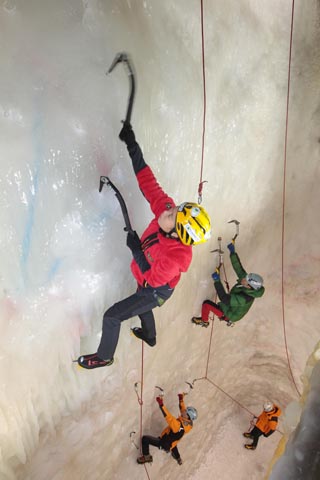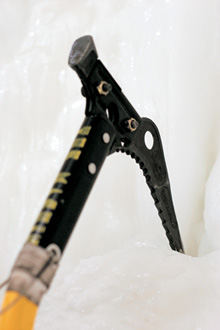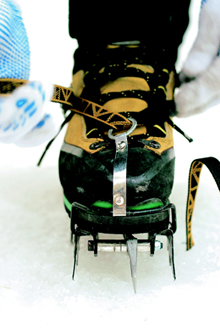How to become a mountaineer while staying inside

Visitors climb the world’s largest indoor ice wall at the Kolon Alpine School Education Center in northern Seoul. By Oh Jong-taek
For Korean winter sports lovers, the cold months are traditionally about basketball, with the baseball fields frozen over and the gyms packed with ballers.
Those who refuse to be kept indoors can get their sports fix on the slopes. But there is another option less known to Seoulites that offers the dissonant combination of outdoor athletics and heated rooms.
Spiderman on ice (not the musical)
Ice climbing in Korea may seem strange as the peninsula is not branded with the Northern European image of an outdoorsman’s frozen paradise. But considering that Korea is home to some of the world’s best mountaineers, it shouldn’t be much of a surprise.
The history of modern mountain climbing in Korea dates back 80 years to the Japanese colonial era, but ice climbing in particular took off in the 1980s with the development and increased accessibility of the sport’s equipment.
Ice climbers on the peninsula traditionally sought out frozen waterfalls to scale. While Mount Sorak’s Towangseong Waterfall rose as a popular destination, the sport largely remained underground.
However, since Nov. 19, 2005, when senior mountaineer Bae Chang-soon opened the nation’s only indoor ice climbing facility in Ui-dong, northern Seoul, the sport has evolved into a popular winter activity.
The facility was built inside the O2 World building, which is now referred to as the Kolon Alpine School Educational Center. On the base floor of the five-story building is an indoor ice wall that is certified as the world’s tallest by Guinness World Records.
The ice wall measures 20 meters (65.6 feet) high and 13 meters wide, beating the ice wall at the Ice Factor in Scotland, which is 16 meters high. The educational center also has three eight-meter-tall ice walls and three eight-meter-tall ice pillars.

Ice axe is essential equipment for ice climbing.

A crampon
“The number of visitors is different on weekdays and weekends, but this is the peak season,” said Won Jong-min, director of Kolon Alpine School. “However, as the outdoor ice climbing season starts in the next few weeks, it’s not going to be too crowded.”
Ice climbing heaven, indoors
Visitors can enjoy ice climbing at a relatively cheap price, with the equipment rental fee at 15,000 won ($13), a one-hour pass costing 10,000 won and a three-hour pass 30,000 won. If visitors think they will come often, the school also offers monthly and annual passes. For beginners who wish to learn ice climbing from scratch, the center offers a class with certified instructors. Tuition varies by curriculum.
“Ice climbing is very easy to learn compared to rock climbing because it uses and relies on equipment,” said Kim Seong-gi, chief instructor at the ice climbing center. “In an hour, anyone can learn the technique of ice climbing.”
Mountaineer experts say those who wish to climb ice walls outdoors but have no experience at all should feel comfortable starting off on indoor walls since it is much safer. The ice is maintained regularly to prevent melting, and certified instructors are there to help.
School officials said they are currently running 10 air conditioners 24 hours a day and are keeping the temperature under minus 5 degrees Celsius (23 degrees Fahrenheit) to keep the ice fresh.
Just like other outdoor sports, ice climbing not only allows for rigorous physically exercise but is also good for mental strength. According to Kim, it is an especially important sport for teenagers.
“Visitors will have strong feelings of accomplishment when their ice axes hit the right spot and they overcome difficult situations,” Kim said. “Since ice climbing requires help from others, visitors can also learn how to trust and cooperate with other people.”

A crampon is essential equipment for ice climbing. [JoongAng Ilbo]
“The climbing terms we use here are usually in English, and we will demonstrate with actions anyway,” Kim said. “If that doesn’t work, instructors will speak in body language,” he added, laughing.
The center has become a mecca for those practicing outdoor sports in Korea. In addition to its world-record ice wall, it also has artificial rock climbing facilities. The building has a lecture room that can accommodate 100 people and also has a lodging place on the third floor for 80 people, meaning group visits and overnight stays are possible. Shower rooms and restaurants are also in the building.
The ice climbing facility is open from 2 to 11 p.m. on weekdays and 10 a.m. to 6 p.m. on weekends. To visit the education center, take bus 101, 109, 144, 151 or 1166. Suyu and Ssangmun stations of line No. 4 are nearby. For more information, visit www.kolonschool.com or call (02) 990-0202.
By Joo Kyung-don [kjoo@joongang.co.kr]










with the Korea JoongAng Daily
To write comments, please log in to one of the accounts.
Standards Board Policy (0/250자)